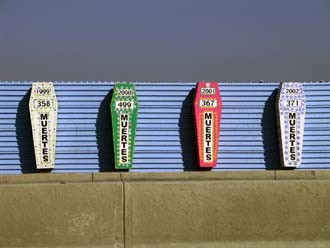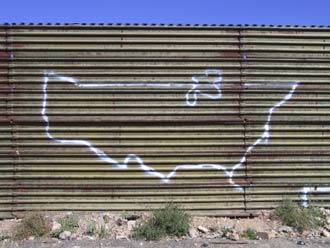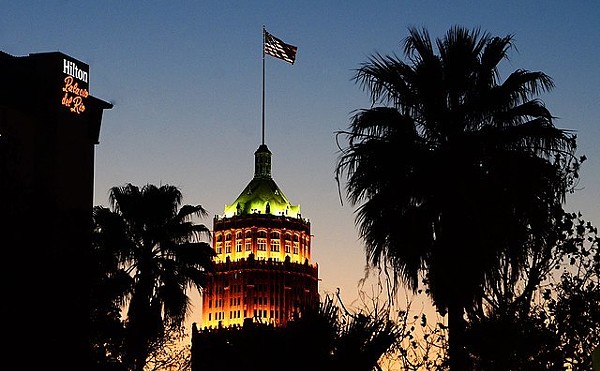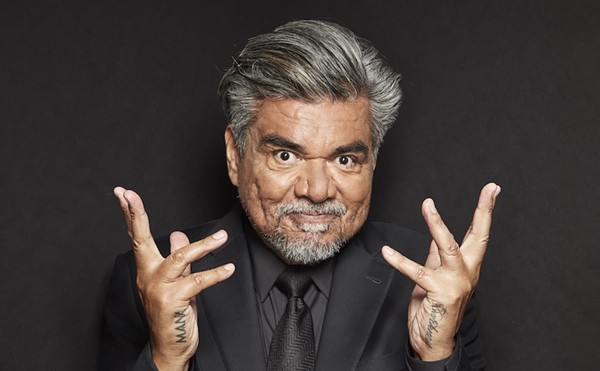|
Anne Wallace makes a pilgrimage to the U.S.-Mexico border and returns with a well-targeted installation A motley grid of used water bottles welcomes viewers to Anne Wallace's current exhibit at ArtPace. Wallace, a 2004 International Artist in Residence, used her time and stipend to pursue themes that have long been part of her work: water as scarce resource and prized commodity, the bond between culture and environment, human rights and our relationship with our Mexican neighbors. The result is a quietly wrenching video compiled of footage filmed during a long roadtrip along the 2,000-mile U.S.-Mexico border from El Paso to San Diego. On her journey, Wallace spoke with humanitarian aid workers whose attempts to save border crossers from dying of thirst in the desert are thwarted by opponents who slash the bottles or run them over. She interviewed residents who speak proudly of the boxes that instruct would-be migrants to push a button for help; when they do, the border patrol promptly arrives. One man tells of an immigrant who refused to turn back toward a border-patrolled road rather than face dehydration in the desert. "I would rather die trying to feed my family," he said, echoing Emiliano Zapata's call to arms. Other voices describe items left behind as individuals struggle north for work: baseball caps and pictures, items for remembering loved ones and for conjuring an American future. Yet these people - desperate enough for a better life to risk life, limb, and separation from all they know and love - are progressively dehumanized by the battle to seal the border. Wallace's camera tracks the crude wall that separates a good stretch of Mexico from the U.S. In places it is lined with crosses and small coffins counting the dead and missing, silent pleas to a distant power.
Wallace's fellow resident, Wangechi Mutu, born in Kenya and now residing in New York, also takes on Texas myth and history with "Hangin' in Texas." You no doubt caught the double entendre. Inside the gallery, unlabeled wine bottles are suspended upside down, the dripping liquid echoing blood in color and odor. Impact divots cover the walls, stained wine red and recalling, among other things, James Byrd's violent dragging death in Jasper in 1998. On the wall a video loop titled "Cutting" features Mutu in sunset silhouette beating something, maybe a tree stump, with a machete. The implication I preferred is that she is beating a plowshare into a sword (in Africa a machete has often been both), but that's pure speculation. Or hope, because without that subtext, the installation doesn't offer much new insight or energy. Mutu has taken the easy way out with a difficult subject, personalizing an experience she has had only vicariously in this country. The accompanying essay says that she is making a universal connection between violence here and in Africa, but violence has specific social, political, and historical roots, usually bound to resources. Byrd's murder, for instance, was heinous and is most often invoked to talk about how Texas hasn't changed; but Byrd's murderers went to prison (two of them to death row), convicted by a local jury, and the Jasper county prosecutor called the feds to tell them he had a hate crime on his hands even before the media came to town. Which is to say, there's plenty to be angry about here and now, but it isn't in the past and it isn't the past, either. The wine bottles are a more potent reminder that, while we must never forget history, the current battles for human rights in America are being fought in school districts, hospitals, at job sites, and in farm fields where immigrants from Latin America receive substandard pay to work among poisonous chemicals. In contrast, Mutu's earlier collages, which have earned her a lot of notice, are excitingly contemporary. In style and aesthetic they most closely challenge Gustav Klimt's gilded cages, with cyborg-like creations in which native beauty and identity are mutilated, attacked, mocked, and sold out. Maybe "Hangin' in Texas" is an attempt to explore the roots of current concepts of race and race relations, but somehow it feels regressive. "98% owns 2%" read the T-shirts printed to accompany Milica Tomic's "Reading Capital," in which wealthy San Antonians such as attorney Bob Price and Linda Pace herself recite excerpts from Karl Marx' Das Kapital. Tomic envisioned the project as a conceptual version of 1930s avant-garde filmmaker Sergei Eisenstein's idea for a film utilizing a method he called dialectical montage, discovering hidden meanings by bringing conflicting elements into dialogue with one another. The effect of watching the well-to-do lip synch criticisms of the system which has benefited them tremendously is ironic to the point of pathos, but the real mental distress comes from trying to parse capitalism's benefits and detriments.
The same breathtaking level of integrity in form and idea is found in Robert Pruitt's "Chandelier," constructed of tiny crack vials. In one stroke it evokes the disparity between white and black users, between society kids who drive downtown to buy and the poor kids who sell. In the background, his sardonic updates of iconic Norman Rockwell images feel merely clever, an invitation to a stand-off. But upstairs, from Wallace's "el otro lado (the other side)," the sounds of an annual volleyball game, played defiantly over the barrier that divides a once-united community, hit home. • By Elaine Wolff
|
Tags:

KEEP SA CURRENT!
Since 1986, the SA Current has served as the free, independent voice of San Antonio, and we want to keep it that way.
Becoming an SA Current Supporter for as little as $5 a month allows us to continue offering readers access to our coverage of local news, food, nightlife, events, and culture with no paywalls.
Scroll to read more Arts Stories & Interviews articles
Newsletters
Join SA Current Newsletters
Subscribe now to get the latest news delivered right to your inbox.
















